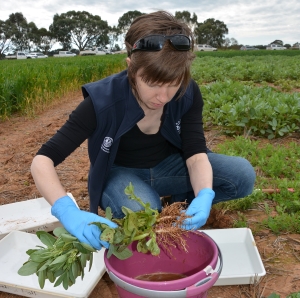Remember the four Cs when checking legume nodulation
Remember the four Cs when checking legume nodulation
Date: 07 Aug 2020

Grain growers are encouraged to follow four simple steps when checking the status of legume nodulation over winter and early spring – collect, clean, count and calculate.
Grain legume crops and pasture legumes initiate a symbiotic relationship with rhizobia bacteria to form nitrogen-fixing root nodules. This nitrogen fixation process has a national benefit of close to $4 billion annually in Australian cropping systems.
Researchers working on a Grains Research and Development Corporation (GRDC) investment, which aims to improve nitrogen fixation in pulses, believe growers could be missing out on the full benefits of correctly inoculated pulses.
University of Adelaide University Research Associate Maarten Ryder says the optimal time for nodulation checks is 10-12 weeks after emergence.
Dr Ryder says successful legume nodulation indicates adequate nitrogen fixation will occur, benefiting the legume, the soil and future crops.
“If growers have gone to the trouble of inoculating legumes at seeding, it is worthwhile to find out if the inoculant has actually worked,” he says.
“For those who haven’t inoculated, it is also worthwhile checking nodulation to observe whether there is adequate nodulation from the rhizobia in the soil, or if inoculation is required in the future.”
The four Cs of legume nodulation checks are as follows:
1 – Collect samples
Plan to conduct nodulation checks at about 10-12 weeks after emergence. Collect approximately 10 plants at three sample sites from a paddock and place them in separate buckets. Dig up roots and soil carefully to at least 10 centimetres deep.
2 – Clean samples
Clean the root system of each plant carefully with water in a bucket and rinse a couple of times. For heavy soils, soak in water 30 minutes. Float the root systems in water in a tray, preferably white plastic, for easy observation.
3 – Count the nodules
Count the nodules on the plants (to the nearest five or 10) and also cut a few nodules open to look for a healthy red/pink colour for indications of effective nitrogen fixation. White or green nodules indicate ineffective fixation. Desirable nodule numbers vary by legume type. Look for around 50 or more nodules per plant for vetch, field pea, faba bean and lentil and 10-30 nodules per plant for chickpea. For more information on desirable nodule numbers and what to look for visit GRDC Tips and Tactics: Legume and Nitrogen Fixation.
4 – Calculate the nodulation rating
Work out the percentage of plants adequately nodulated from each sample site. Good nodulation is at least 70 per cent plants adequately nodulated across the three samples. A poor rating is when less than 50 per cent of plants have adequate nodulation for the crop type. If any particular part of the paddock is poorly nodulated, consider possible causes, such as soil type, and plan for future remedies including higher inoculation rates.
Further information on conducting nodulation checks, consult the 10 Dos and Don’ts of legume nodulation checks Paddock Practices article.
The GRDC’s Inoculating legumes: A practical guide, provides further comprehensive information.
Contact details
For interviews
Maarten Ryder, University of Adelaide
0409 696 360
Contact
Bridget Penna, AgCommunicators
08 8332 3277
GRDC Adelaide office Communications Manager – South
(08) 8198 8400
media@grdc.com.au
GRDC Project Code: 9176601,

